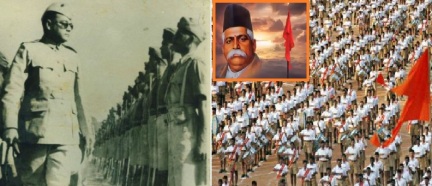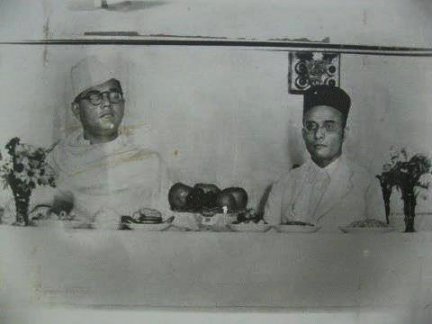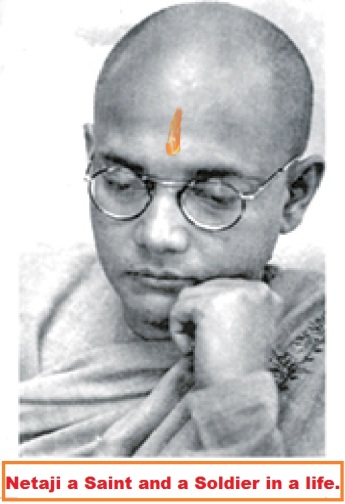As the nation, or what passes for it in this wondrous land with an abysmally poor sense of history, observes the 118th birth anniversary of Netaji Subhas Chandra Bose, perhaps the time has come for one of India’s great leaders to be freed from the confines of political myth-making that has reduced him to calendar lithographs which adorn living rooms in provincial Bengal and the dimly lit offices of the Forward Bloc in Kolkata.
In a sense, that would mark the posthumous homecoming for a nationalist who believed that rashtrabhakti is a synthesis of religion and nationalism, of the spiritual and the political. In the early decades of this century, when others were looking up to Mohandas Karamchand Gandhi for inspiration, Bose was looking elsewhere for guidance: His search for a religious philosophy that would spur political activism led him to explore the teachings of Swami Vivekananda and the writings of Aurobindo Ghosh. The latter made a lasting impression on his mind, providing his political activism with a religious side.
The profound Impact that Aurobindo Ghosh had on Subhas Chandra Bose is reflected in his autobiography: “In my undergraduate days, Aurobindo Ghosh was easily the most popular leader in Bengal… a mixture of spirituality and politics had given him a halo of mysticism and made his personality more fascinating to those who were religiously inclined… We felt convinced that spiritual enlightenment was necessary for effective national service…”
It is, therefore, not surprising that he should have also been influenced by Bankim Chandra Chatterjee’s construction of nationalism. And like Aurobindo Ghosh, Bankim Chandra Chatterjee and Bal Gangadhar Tilak, the Indian nation for him extended beyond the geographical to the devotional plane. During his college days he discovered the wretchedness of not India but “impoverished Mother India.”
Curiously, his view of the other India, the one which appears so distant from the fashionable drawing rooms and glittering malls of our cities, is not different from those who believe that a divide separates ‘us’ and ‘them’. For, “the picture of real India”, which Subhas Chandra Bose described as “the India of the villages where poverty stalks the land, men die like flies, and illiteracy is the prevailing order”, is also the India which many believe should receive priority over that India which revels in rejecting anything that carries the label ‘Made in India’, including Hindu spirituality and religious philosophy.
In his book, Brothers Against The Raj, Leonard A Gordon writes about Bose’s quest for a religious philosophy to serve as the core of nationalism and sustain his political activism: “Inner religious explorations continued to be a part of his adult life. This set him apart from the slowly growing number of atheistic socialists and communists who dotted the Indian landscape.” And it was this “religious exploration” that set apart Subhas Chandra Bose from Jawaharlal Nehru for whom “this was a vain quest”. Although Bose scrupulously avoided publishing his faith or his quest, he remained firm in his belief that “Hinduism was an essential part of his Indianness”, his Bharatiyata. In other words, he subscribed to cultural nationalism or, call it If you must by its other name, Hindutva.
This did not, however, make him a bigoted Hindu, nor did it propel him towards Hindu orthodoxy. Commenting on the “definite Hindu streak in Bose’s dislike for Gandhi”, Nirad C Chaudhuri records in his memoirs, Thy Hand! Great Anarch, “He was in no sense a bigoted or even orthodox Hindu. But he had grown up in the first two decades of the twentieth century in Bengal, where, owing to the influence of Bankim Chandra Chatterjee and Swami Vivekananda, there was a fusion of religion and nationalism, so that the nationalist feeling had a pronounced Hindu complexion and Hinduism a pronounced political character.”
This “fusion of religion and nationalism” and Hinduism with a “pronounced political character” came into play in 1925 when during his incarceration at Mandalay prison, Subhas Chandra Bose, along with the other Bengali prisoners, organised Durga Puja on the jail premises and demanded that the expenses be borne by the authorities. When the latter refused, Bose converted his spiritual quest into a political campaign by launching a hunger strike. This practice of political Hinduism had an electrifying impact on public opinion and soon the Swarajists lent their voice to the popular demand for the release of all political prisoners who had not been charged with specific crimes.
Those who deride nationalism, more so cultural nationalism, as narrow, selfish and aggressive, a hindrance to the promotion of internationalism, would do well to go through Bose’s speech at Poona after being elected president of the Maharashtra Provincial Conference. “Indian nationalism,” Subhas Chandra Bose asserted, “is inspired by the highest ideals of the human race, Satyam, Shivam, Sundaram. Nationalism in India has… roused the creative faculties which for centuries had been lying dormant in our people…”
Sadly, nationalism has now been rendered politically incorrect by our deracinated intelligentsia and abandoned by our corrupt political elite. [Originally published in Niti Central]
Hedgewar-Netaji Contact
~ Rakesh Sinha
 Keshava Baliram Hedgewar (April 1, 1889 – June 21, 1940) was the founder of the Rashtriya Swayamsevak Sangh (RSS). Hedgewar founded the RSS in Nagpur, Maharashtra in 1925, with the intention of promoting the concept of the Hindu nation. Hedgewar drew upon influences from social and spiritual Hindu reformers such as Swami Vivekananda, Vinayak Damodar Savarkar and Aurobindo to develop the core philosophy of the RSS.
Keshava Baliram Hedgewar (April 1, 1889 – June 21, 1940) was the founder of the Rashtriya Swayamsevak Sangh (RSS). Hedgewar founded the RSS in Nagpur, Maharashtra in 1925, with the intention of promoting the concept of the Hindu nation. Hedgewar drew upon influences from social and spiritual Hindu reformers such as Swami Vivekananda, Vinayak Damodar Savarkar and Aurobindo to develop the core philosophy of the RSS.
He went to Kolkata to pursue a Degree in Medicine. After successful completion, Hedgewar was drawn into the influence of secret revolutionary organisations like the Anushilan Samiti and Jugantar in Bengal.
He was also a member of the Hindu Mahasabha till 1929. Hedgewar was imprisoned for sedition by the British government in 1921 for a year and again in 1930 for nine months. After his spell in prison he instructed the RSS to remain aloof from political activities including the Salt Satyagraha (1930) and continue mainly as a social organisation.
Dr. Hedgewar regarded independence and national unity as complimentary, like two sides of the same coin. Therefore, even after embarking upon the work for national unity he did not abandon working for independence. In the year 1928, he took part in the Congress convention held in Calcutta. There he discussed about the Sangh mission and about the national situation with Netaji Subhash Chandra Bose. Both the leaders exchanged views on the number of subjects concerning the Indian nation and appreciated each others point of view.
In the year 1930 in its Lahore convention. Congress declared “full freedom” as its objective. Dr. Hedgewar was naturally delighted at this.
http://kvpuniverse.org/About%20Dr.html
Hedgewar as a medical student in Calcutta had been part of the revolutionary activities of the Anushilan Samiti and Jugantar. (Chitkara M G, Hindutva, Published by APH Publishing, 1997 ISBN 8170247985, 9788170247982)
He was charged with sedition in 1921 by the British Administration and served a year in prison. He was briefly a member of Indian National Congress. In 1925, he left the Congress to form the Rashtriya Swayamsevak Sangh, which would become the focal point of Hindu movements in Independent India. After the formation of the RSS too, Hedgewar was to take part in the Indian National Congress led movements against the British rule. He joined the Jungle Satyagraha agitation in 1931 and served a second term in prison. The Rashtriya Swayamsevak Sangh started by him became one of the most prominent Hindu organization with its influence ranging in the social and political spheres of India.
Hedgewar’s political career begins from 1905 and ends with his death in 1940. In the first phase (1905 – 1918) of his political life, he was ‘an unalloyed Tilakite. Maharashtra witnessed two simultaneous lines in the public life one, propagated by Agarkar, emphasised the necessity of social radicalism as precondition of political change. But, Tilak emphasised on political activities as the first priority. Hedgewar endorsed Tilak’s approach.
Pandurao’s Khankhaje, leader of Swadesh Bandhav, a revolutionary organisation, wrote in Kesari, “Hedgewar and the other young men were in the forefront of Swadeshi propaganda and delivering speeches”. After joining National Medical College in Calcutta in 1910 with the sole aim to participate in revolutionary activities, he became active member of “Anushilan Samiti” with his code name “Koken”. He was closely associated with revolutionaries like Nalini Kishor Guha (who provides authentic account of Hedgewar’s revolutionary activities in Calcutta during his stay from 1910 – 1916). After his return from Calcutta to Nagpur, he used his contacts to organise revolutionaries with a plan of “armed revolt” which, according to P.L. Joshi (in his article “Mobilisation in Vidharba by Tilak in political thought and leadership of Tilak” edited by N.R. Inamdar P.370) was dropped on the advice of Tilak. Hedgewar’s revolutionary group was the biggest one and consisted of 150 hard core revolutionaries. G.M. Huddar says Hedgewar’s revolutionary group resembled a secret “conspiratorial group” of young men. (G.M. Huddar in -RSS and Netaji in the Illustrated Weekly of India, Oct. 7,1 1979). His plan of armed revolt was not an isolated case of adventurism but it was coincided by his manifesto for Indians Independence which was to be declared from many countries. He postponed his plan on the advise of Dr B. S. Moonje. (Hedgewar’s role in freedom struggle – Indian Express, Rakesh Sinha – 24 June 1996)
Savarkar-Bose Meet
~ Balbir K. Punj
 A meeting which took place between Bose and Savarkar in Bombay in June 1940. On this occasion Savarkar is supposed to have suggested to Subhas that he should go to Europe and seek the dictators’ support. According to a article in the Times of India of June 24, Mr Bose had also talks with Mr V D Savarkar, president of the All India Hindu Mahasabha, at the latter’s residence at Dadar on Saturday evening. It is understood that the discussions related to the present political situation in the country and the steps the Hindu Mahasabha and the ‘Forward Bloc’ should take in co-operation with other parties. The episode, as always, did not go unnoticed by the police, who gave a brief account of it:
A meeting which took place between Bose and Savarkar in Bombay in June 1940. On this occasion Savarkar is supposed to have suggested to Subhas that he should go to Europe and seek the dictators’ support. According to a article in the Times of India of June 24, Mr Bose had also talks with Mr V D Savarkar, president of the All India Hindu Mahasabha, at the latter’s residence at Dadar on Saturday evening. It is understood that the discussions related to the present political situation in the country and the steps the Hindu Mahasabha and the ‘Forward Bloc’ should take in co-operation with other parties. The episode, as always, did not go unnoticed by the police, who gave a brief account of it:
Subhas Chandra Bose arrived in Bombay on June 22nd and had discussions with V D Savarkar with a view of exploring the possibilities of co-operation between the Forward Bloc and the Hindu Mahasabha respectively. (MSA, Home Special Department, 1023, 1939-40, SA dated June 29, 1940, ‘Forward Bloc’).
The absence of accounts by the Hindu Mahasabha on the meeting can be explained by the fact that, both the leaders being involved in anti-British activities, it would not make sense leaving records of sensitive matters. Not even among Bose’s papers and writings is there any reference to the meeting. It is therefore impossible to reconstruct the content of the talks between the two leaders, unless we trust the only source available. This is the speech made by Savarkar on the occasion of the dissolution of the Abhinav Bharat in 1952. Certainly the meeting did take place, and very possibly the two leaders discussed Bose’s intention to go to Europe and seek the support of the axis powers. Savarkar inspired Bose, who, right from 1933, had his own connections with the dictators’ governments. The working committee of September 10 decided which steps should be taken in order to prepare the nation to face the emergency provoked by the outbreak of the war.
The preliminary condition was the devolution of full powers to a central Indian government by the British. The committee wished for the realization of the militarisation of Indian society and the Indianisation of the army. It requested a reform of the Arms Act, along the lines prevailing in the UK. It demanded also that territorial forces and paramilitary groups be strengthened, that new military organisations be created in those provinces where they did not exist before.
(NMML, Moonje papers, subject files, n 51).
A study of relations between two towering contemporaries Veer Savarkar (1883-1966) and Netaji Subhas Chandra Bose (1897-1945?) will prove interesting. On the “longest day,” June 21, 1940, Subhas Chandra Bose called on to Savarkar at Savarkar Sadan, Bombay. Savarkar advised Subhas not to waste time in agitating for the removal of British statues like Holwell Monument in Calcutta – only to end up in a British prison during the invaluable war-time. Savarkar, was surreptitiously in touch with Rash Behari Bose in Japan. He advocated that Subhas should smuggle himself out of the country and try to reach Germany and Japan (like Indian revolutionaries duri ng World War I) to raise an Indian Army of liberation out of PoWs. In his avatar as Netaji, Subhas Bose’s future course of action developed on the prophetic lines of Veer Savarkar.
Netaji in his speech on Azad Hind Radio (June 25, 1944) acknowledged Savarkar’s perspicacity in these words: “When due to misguided political whims and lack of vision, almost all the leaders of Congress party have been decrying all the soldiers in Indian Army as mercenaries, it is heartening to know that Veer Savarkar is fearlessly exhorting the youths of India to enlist in armed forces. These enlisted youths themselves provide us with trained men and soldiers for our Indian National Army.”
On September 30, 1943 when Netaji Subhas Chandra Bose toured Andaman as the supreme commander of Azad Hind Fauz, he paid his tributes to the memories of freedom fighters imprisoned in the Cellular Jail. He got printed thousands of copies of the Tamil version of Savarkar’s Indian War of Independence of 1857 and distributed them in public. Andaman and Nicobar islands were re-named as Saheed and Swaraj islands.
Savarkar reciprocated these noble sentiments, but alas, Subhas was not there to see it. On May 10, 11, and 12 1952 during the dissolution celebration of Abhinav Bharat, the secret revolutionary party Savarkar had founded in 1904 at Pune, the bust of Netaji graced the stage for three days. Hailing Subhas as “deathless” Savarkar said, “Long live deathless Subhas, victory to the goddess of freedom.”
Yet, having said all that, in the end, I can’t help remembering an illustrious exception. Veteran communist parliamentarian and prolific scholar Prof. Hiren Mukerjee (who years later penned a study on Netaji Subhas called Bow to the Burning Gold) on February 28, 1966, that is two days after Savarkar passed away, proposed that the Lok Sabha should pay homage to Savarkar, in recognition of his services to the nation. He was supported by U.M. Trivedi of the Jan Sangh. Prof. Hiren Mukerjee said that although Savarkar was not a member of the House, there should still be some way in which the House should register its feelings on the passing away of a great leader. The House had done so in the case of Mahatma Gandhi and Stalin who were not members of the House.
Though, ultimately the House did not formally pay any homage, by observing silence, Speaker Hukum Singh conveyed the sentiments of the House to the bereaved family through the secretary of Lok Sabha. On March 4, 1966 when Union ministers, Opposition leaders, the Speaker of the Lok Sabha paid homage to Savarkar in a condolence meet organised by Delhi’s citizen’s council, Prof. Hiren Mukerjee, though differing from some of Savarkar’s views, had praised the potent brand of nationalism that he championed. Earlier Mukerjee was the one who had denounced All India Radio for not taking note of Savarkar’s Mritunjaya Diwas celebration on December 24, 1960.
Yet given their shady history it is not unnatural that the example of Hiren Mukerjee would be lost upon the communists. (Subhas vs Savarkar, Author: Balbir K. Punj, Publication: The Asian Age – Date: May 20, 2002)
The Hindutva Legacy of Netaji
~ Animitra Chakroborty.







